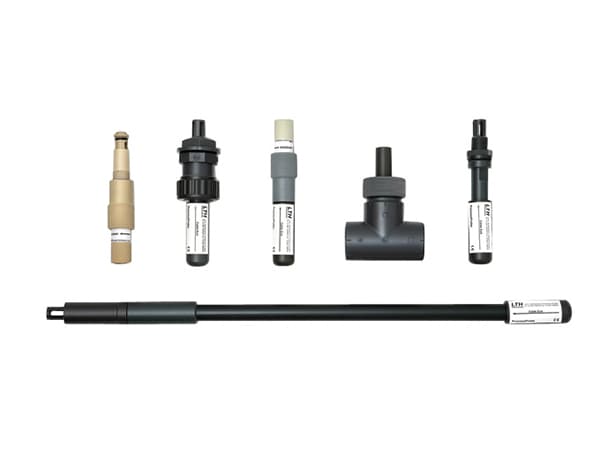Products

Redox or ORP measures the total activity of a solution in mV or the total of reducing and oxidizing activities in a solution. Redox or ORP measurement ORP is useful for monitoring and controlling the addition of oxidizing agents such as chlorine, bromine, and ozone or reducing agents including cyanide, sodium bisulfite and metabisulfite.
A Redox electrode does not have to be “calibrated” but it can be tested if required by using a Standard Redox or ORP Test Solution. LTH can offer a suitable Redox test solution. Please contact our sales department with your request.
This varies depending on a number of factors: Accuracy required, how clean the application is, process operating temperature and pressure. We would normally recommend that you initially calibrate once per week. If you find after a number of weeks the calibration is remaining within tolerance you can then extend the period between calibrations.
1. General: Wash with a solution of liquid detergent and warm water by gently scrubbing with a soft tooth brush or soft tissue. Follow with a thorough rinse in D.I. or tap water.
2. Inorganic Deposits: Try to dissolve the deposit by immersing the electrode bulb in 0.1N Hydrochloric acid for a few minutes followed by a thorough rinse with D.I. or clean tap water. Then proceed with the general cleaning in Step 1 of this section.
3. Organic Oil, Grease Films or Fingerprints: Wash the electrode bulb with the solution in Step 1 of this section. Wash the tip with acetone. Follow with the general cleaning procedure in Step 1 of this section. Note: Depending on the extent of the oil and/or grease contamination, the electrode may be damaged beyond recovery.
4. Plugged or Dry Ceramic Liquid Junction: Try at least one of the previous 3 steps in this section. Place the electrode in KCI solution, 2M or stronger. Heat slowly to 50ºC then let cool to room temperature. Repeat as necessary.
Yes, once the conductivity drops below 50µS/cm problems can be introduced.
Standard pH electrodes contain 3.5M KCl as a reference gel. Samples like DI water and other low ionic solution contain very small amounts of salt. These solutions try to leach ions from the reference gel to raise their conductivity levels. This results in very slow, sluggish, and unstable readings from a conventional pH electrode.
Once you go below this value we recommend using an electrode suitable for Low Ionic strength water and Low Ionic strength buffer solutions.
Our pH electrodes conform to the Nernst Equation for pH output as a function of temperature. At 25°C, the pH output is 59.16 millivolts per pH unit. The electrode will give a zero output at a pH of 7.0 at all temperatures.
Redox or ORP is expressed in millivolts (mV). A range of -1999 mV to +1999mV is common with ORP instruments.
Yes, the life of the pH electrode will greatly shortened. All pH electrode bulbs should be kept wet at all times.
Never store a pH electrode dry. We would recommend a Potassium Chloride or KCl solution. We recommend any concentration between 2.0 M and 3.8 M. An alternative choice is a pH buffer solution. A pH 4 buffer solution is best since it will keep longer, but pH 7 is also acceptable. Never store the pH electrode in deionised water (DI).
To obtain the most accurate pH measurement, it is important to compensate for temperature. Temperature has two significant effects on pH readings. The solution pH and the electrode output will both change at different temperatures. These two effects, either together or separately, can lead to errors in calibration, measurement and control.
A pH sensor must be mounted at least 15° above the horizontal to consistently function properly. The liquid in the sensor contains small air bubbles. If not inclined slightly above horizontal, a bubble can adhere to the pH bulb where it will affect the sensor’s performance.
Related products
Provide your details below and a member of our team will be in touch with you. Alternatively, you may reach us directly at +44 (0)1582 593 693.
